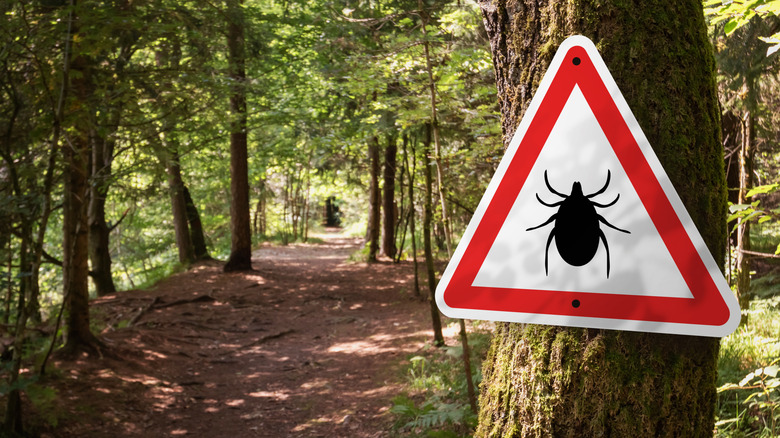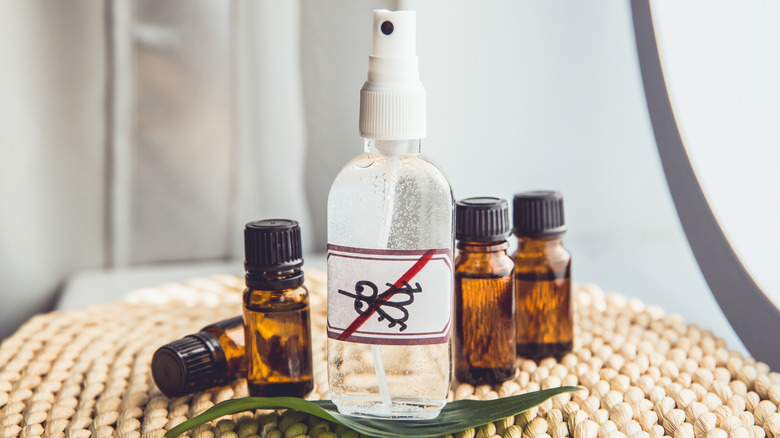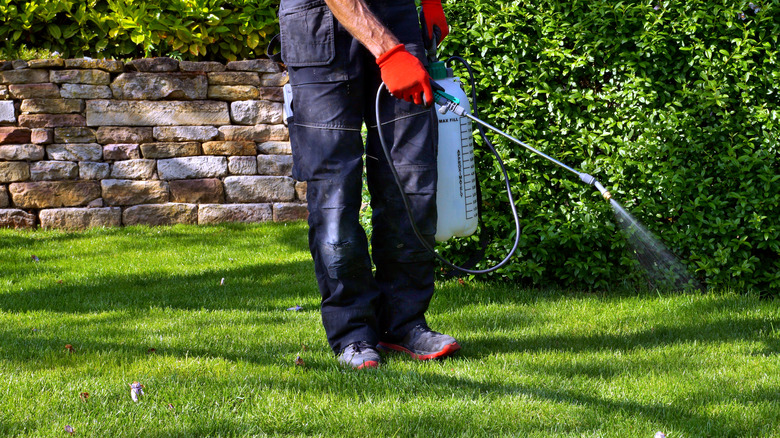9 Ways To Protect Yourself And Your Home From Ticks This Year
We may receive a commission on purchases made from links.
Summer is a beautiful time of year when animals are out and about, flowers bloom, and bug populations flourish. Some insects benefit your home and garden, but ticks are not one of them. Ticks bite people and pets alike, spreading bloodborne diseases. Homeowners should take every measure possible to deter and eliminate these dangerous pests from their yards and homes.
Ticks aren't just a nuisance; they're known spreaders of bacteria, diseases, and parasites. Fortunately, the danger of ticks is well-known to the public. Given the widespread fear, there are both old school and modern solutions to control, prevent, and even eliminate them. These methods range from all-natural to chemical-laden formulas, both of which are backed by universities and scientific studies. A combination of natural and synthetic approaches keeps you, your household, and your home safe, and these secret weapons ultimately ward off ticks from yards and gardens. Read on to learn about actionable ways to defend your home from ticks, as well as how to implement them successfully.
Avoid growing plants that attract tick hosts
Although science has proven that plants alone aren't enough to deter ticks from your yard, there are landscaping choices that reduce the likelihood of ticks. Many plants don't attract ticks directly, but they do attract their hosts. Ticks cling to various wildlife species, including birds, deer, rabbits, skunks, stray dogs and cats, as well as other common wild animals. The less appealing your garden is to wildlife, the less likely they are to venture into your yard and bring ticks along with them. Therefore, the easy answer is to plant wildlife-resistant plants that can save your garden and keep ticks off your property.
When fruits and vegetables ripen for harvest, they naturally attract animals that are known tick carriers. It will be challenging to keep these gardens from attracting tick hosts, even if planting strong-smelling plants that deer and rabbits dislike. You aren't safe with ornamental gardens, as they can be just as attractive. Still, the fewer edible plants present, the less appealing the yard. Do your research before planting — deer and rabbits tend to avoid plants with strong smells and heavy sap. Plant shrubs like boxwood, buckwheat, and holly. For perennial flowers, you can use popular species like begonias, crocus, daylilies, forget-me-nots, and daffodils. For a more comprehensive list, visit the Arizona Cooperative Extension's list of Deer and Rabbit Resistant Plants.
Build a fence to keep tick hosts out
If tick-infested wild animals seem intent on coming on your property despite your careful plant choice, take more direct action against them. Invest in a fence installation or DIY a protective and affordable home fence. A fence that completely encloses a yard keeps animals, and their tick hitchhikers, out. Ticks need blood to survive. If there are no animals in a yard for them to feast on, they won't thrive on the property.
Be wary that building a garden fence that successfully keeps wild animals out isn't as easy as it sounds. Wild animals will find a way to get over or underneath your fence if they really want to. Study local wildlife populations and consider what the biggest threats are to your property. If your neighborhood has many deer, focus on a taller fence rather than a deep one — deer are known to jump over 7-foot tall fence lines. If smaller creatures, like rabbits and raccoons, are more widespread, a buried wire fence will keep them from digging underneath. It's imperative that either fence is installed correctly. If there are any weak points or gaps, animals are more likely to find a way through.
Make your yard less attractive to tick infestations
Hinder ticks with the same effort that's put into obstructing their hosts: Design a yard to be as inhospitable as possible while still maintaining a gorgeous aesthetic. This practice doesn't directly repel the insects, but does make a yard less appealing than neighboring properties or forested areas. Know that ticks prefer shaded areas with overgrown foliage for shelter. They're far more likely to be found in these places than in manicured lawns with trimmed foliage and wide barriers between greenery.
Don't let yard debris accumulate. Clean up fallen leaves, gather broken branches, bag up grass clippings, and use easy green methods to get rid of your home landscape waste. Create barriers that ticks won't want to cross to get from your garden or surrounding properties to reach your home and outdoor seating areas. For example, lay at least 3 feet of gravel, mulch, and wood chips as spacers between garden areas, outdoor seating areas, playgrounds, the house itself, and nearby wooded areas. Ticks won't willingly cross these sunny, unshaded areas without reason, overall giving them less reason to linger and make your property their breeding ground.
Arrange your outdoor seating areas in sunny, well-manicured spots
Don't let a fear of ticks keep the household and guests from enjoying the summer weather. Outdoor seating areas can be kept tick-free as long as they're relatively inhospitable for insect life. Place furniture strategically, choosing sunny areas with minimal plants. Ticks will have no reason to reside in these places when humans, pets, and plants aren't present, as there are no animals to feed from and no plants to take shelter in.
Take care to place your lawn furniture on an inhospitable surface, preferably gravel, mulch, or wood chips, with at least a 3-foot distance on all sides from surrounding gardens or grass. No shade is the best deterrent, but this isn't always practical on sunny and hot summer days. Install an adjustable umbrella on your lawn chairs or table that can open up when enjoying time outdoors. It's important that these features can also close up shop when not in use. The NBtoUS 2-Pack Beach Umbrella with Clamp is good for chairs, and the Yaheetech Outdoor Patio Umbrella fits in the center of outdoor tables with umbrella holes.
Throw your clothes and towels in the dryer after coming inside
Even when taking preventative measures to keep ticks away from a home, it's better to be safe than sorry. Whenever spending a prolonged period outside, especially around forested and overgrown areas, ticks can secretly hitch a ride on clothing. Before they have a chance to crawl under your clothes, reach your skin, or escape into the house, throw dirty outdoor clothes in the dryer upon arrival home.
In a 2016 study by Ticks and Tick-borne Diseases, testing revealed that putting ticks in the dryer for four minutes on high heat killed 100% of them. The scientists recommend running the dryer for six minutes to be on the safe side, but this method is guaranteed to wipe out all ticks. Keep in mind that this study also revealed that most ticks survive cold and warm washes, making the washing machine far less effective than the dryer. Even hot water washes still resulted in 50% tick survival. Therefore, your best bet is to toss your clothes directly in the dryer and worry about the washing after the ticks are ensured eliminated.
Apply tick-repelling essential oils to exposed skin hourly when spending time outside
The natural health community gets a lot of flak for using methods that aren't always backed by science. When it comes to essential oils and ticks, don't worry as much about unverified claims. Scientific testing has revealed that some essential oils, such as cedarwood, are just as effective at deterring ticks as DEET — though the effects may not last as long as chemical deterrents. At a concentration of at least 10%, cinnamon and clove oil stop ticks for over an hour, and thyme oil lasts for just under one hour. These 10% essential oils were mixed with lotion before being applied to skin to prevent skin irritation. Dorothy Leland, vice president of LymeDisease.org also recommends lemon eucalyptus oil, as she told Huffpost, "Studies show that repellents with DEET, picaridin or lemon eucalyptus oil are the most effective against ticks." The oils' strong scents mess with the ticks' olfactory senses. This makes authentic essential oils a great option if you're trying to avoid harmful chemicals. Safely apply them to your skin in small amounts, given you have no allergies, and use a pure essential oil.
When creating a DIY tick repellent, using 100% essential oil is more likely to cause a skin reaction. With this in mind, dilute it while still keeping the recommended concentration. Mix one part essential oil with nine parts coconut oil to create a gentler bug spray for your bare skin. The fatty acids in coconut oil also repel ticks. In summation, this additional ingredient dilutes the essential oil's harshness on skin, but not its effectiveness on ticks.
Coat your clothes in a proven tick repellent
Even if natural methods protect your skin, double down on tick prevention by also spraying down clothes. It's like a second line of defense. Use the aforementioned all-natural essential oils, or use a more chemical-laden tick spray. Since the concoction goes on clothes and not bare skin, it's less likely to cause a rash or other adverse reaction.
When selecting a manufactured tick repellent, look for DEET concentrations between 30% to 40% to ensure it works to its best ability. Also, use formulas with the ingredient permethrin, which is even stronger than DEET and can actually kill ticks. Because of its strength, it's even more vital that it doesn't come into contact with skin. When selecting a bug spray, check the directions, label, and ingredients — all bug sprays are not created equal. A bug spray that targets cockroaches or fleas isn't guaranteed to affect ticks. Also, be wary not to mistake certain chemicals for those of similar names. For example, permethrin has a similar name to picaridin. The difference is that picaridin repels mosquitoes, but not ticks.
Treat pets with tick prevention treatments
Wild animals aren't the only tick carriers bringing these harmful insects into your yard and home. Your pets, especially dogs and outdoor cats, are potential hosts. The best tick treatment is a preventative one, and you should use a routine tick treatment on all pets. Even indoor cats can be potentially exposed to ticks, whether a person or dog unintentionally brings them inside. Tick prevention treatments are oral, topical, or in collar form, and are over-the-counter or prescribed by a veterinarian. All medications affect ticks when they bite your pets by disrupting their nervous systems, paralyzing them, and killing them. The medicine stops the tick from feeding on the animal.
Tick prevention treatments can be costly, but they are cheaper than dealing with the potential medical consequences if gone unchecked. Do not share treatments between dogs and cats. Pyrethrin, a common ingredient in dog pest prevention, is highly toxic to felines. Order a collar, oral pill, or topical treatment for individual animals and treat them according to the instructions. PetArmor Plus Flea and Tick Prevention comes in boxes of three, six, or 12 topical treatment doses, and people typically treat their pets once a month. Ensure you select the correct dog size or cat option before ordering to achieve the best results.
Invest in lawn treatments with pesticides designed to target ticks
Many people feel safest when they turn to the most modern methods to control bugs. A professional lawn treatment around your yard perimeter should stop ticks in their tracks. Pick pesticides designed to target ticks, which should be inscribed in the product label and instructions. Double-check that the pesticide works by verifying that the ingredients are active tick repellents, such as permethrin, bifenthrin, and pyrethrin.
Turn to a landscaping professional to treat your yard, or learn how and when to spray your yard for ticks yourself. The Environmental Protection Agency Repellent Search Tool helps homeowners find the best product for their situation, environment, and insect type. Follow the instructions for applying the chosen product and ensure you're decked out in the right personal protective equipment (PPE). This usually includes eyewear, gloves, a long-sleeved shirt, long pants, shoes, and socks. Disperse the pesticide across most of the yard and concentrate on forested areas where they're the most abundant. Avoid gardens with edible plants, your pets' favorite spots, and outdoor seating areas, since you don't want to expose these chemicals to members of your family. On areas that may be exposed to pets and people, sprinkle diatomaceous earth on your lawn soil to keep ticks at bay. Food-grade diatomaceous earth, like Diatomaceous Earth Store's 5 Lbs Organic Diatomaceous Powder, is non-toxic to pets if used correctly, and kills ticks by dehydrating their exoskeletons.









